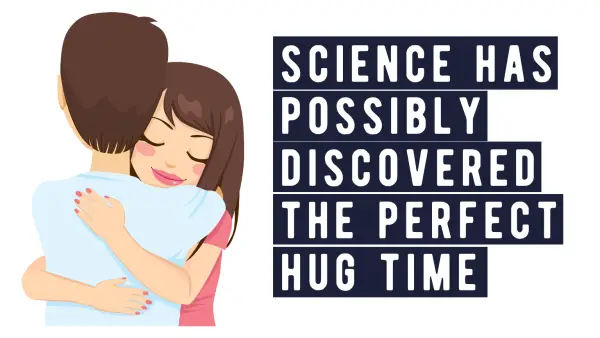Science Has Possibly Discovered The Perfect Hug Time
Tags: opinion

Like everything else in life, timing is the most important. And hugging is no exception. Having the urge to hug someone after getting to meet them in person after a long time is completely natural. But there is such a thing known as the perfect hug, and researchers have determined what makes it so.
Psychologists at London University’s Goldsmiths, have discovered the most important aspects that make a hug ideal. This includes the optimal hugging time and the style in which one squeezes the other.
The Study On Hugging
The researchers discovered that a hug that lasts longer, anywhere between 5 and 10 seconds, had a more positive impact than ones that did not last as long. They also noted that how the arm is positioned – crisscrossed, over the shoulder, or around the waist – did not make any difference. However, even if the research suggests that hugs that are extremely brief should not be done, there was no determination after how long a hug becomes too uncomfortable.
The psychologists claim that this study is possibly the first ever to look at the factors influencing the behavior and evaluation of hugging, as well as whether one’s mood can be affected by it. The recent report was published in Acta Psychologica, a science journal in psychology.
Read: After Spending Two Days Apart Two-Year-Old Best Friends Race To Hug Each Other
48 participants were enlisted – all of them were women. The reason behind this was cited as “resource constraints”. They were paired up and told to hug the other after set intervals of 10, 5, or 1 second. They were also told to hug each other in two different patterns, either “neck-waist” or “criss-cross”. The latter has both huggers embrace each other diagonally, with one of their arms around the other’s side while the other rests off the shoulder. The former embrace would have the huggers have their arms around the other’s neck, or just below their shoulders.
Longer Hugs Equals Better Impact
Volunteers also had to put on blindfolds so that visual feedback could not influence touch perception. Following each session, participants were asked to report on the hugs and how they felt immediately following the hug, 3 minutes after the hug, and finally 6 minutes after the hug. Participants used words like “under control”, “pleasant”, or “arousing” (compared to “awkward”) to describe how they felt after an embrace,
The reports discovered that hugs that lasted for 1 second had fewer people describing them as “under control” or “pleasant” than hugs that lasted for 5 or 10 seconds. Both of the latter saw outcomes that were similarly positive. This made researchers wonder if, after 10 seconds, a person reaches “a plateau in pleasantness”. However the good mood faded with time, and most arousals were felt immediately following the embrace.
Meanwhile, the position of the arm did not seem to have any significant effect on the participants. Experts were surprised because some had believed that neck-waist hugs were not as comfortable as criss-cross embraces.
Read: This Loving Corgi Hugs Every Friend He Comes Across On His Daily Walk!
In a different experiment, researchers were asked to look at 206 women and men hugging on the campus of Goldsmiths. They were then asked to rate the experience between 0 and 100. Despite the height and gender differences, the criss-cross embrace was found to be the more frequent approach. The authors were surprised since a criss-cross embrace between 2 people whose heights were different is usually cumbersome. The study added more data about the difference in approach between women and men when it comes to physical contact with others.
Regardless, as far as this research goes, the psychologists hope that further studies will try to find when hugs can become uncomfortably long. And then, use the data to make “hugging robots”. Well, even if the robots don’t happen, most of us can do with knowing how when a hug becomes too much, right?
SUPPORT US ON PATREON AND GET ACCESS TO OTHER EXCLUSIVE CONTENT, CLICK HERE TO LEARN MORE
FOLLOW MIKE ON INSTAGRAM FOR MORE: @MIKESYGULA
Image credit: 123RF
Leave Comment: